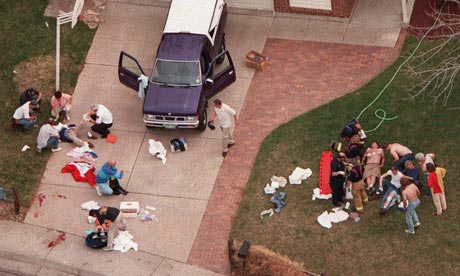 Exactly 10 years ago on Monday, the world woke up to learn that two more unhinged American teenage misfits had snapped after years of bullying at the hands of the "jocks", the sporting overlords of their universe, and gone on a murderous rampage with semi-automatic weapons through their suburban high school.
Exactly 10 years ago on Monday, the world woke up to learn that two more unhinged American teenage misfits had snapped after years of bullying at the hands of the "jocks", the sporting overlords of their universe, and gone on a murderous rampage with semi-automatic weapons through their suburban high school.
Or that's the version we were told, anyway.
The teenagers were called Eric Harris and Dylan Klebold, and their school was Columbine High, an idyllic sounding place nestled between the Denver metropolitan area and the foothills of the Rocky Mountains. What is indisputable is that Columbine quickly became a byword for the nightmarish phenomenon - now seemingly a worldwide contagion - of school shootings. It was the bloodiest, creepiest, most vivid school attack anyone at the time could remember and remains, to this day, the episode the American popular imagination just can't seem to shake.
Harris and Klebold did not just gun down their victims in cold blood. They laughed and hollered while they were doing it, as though they were having the time of their lives.
In contrast to previous American school shootings, which had unfolded in hard-to-reach locales such as West Paducah, Kentucky, or Jonesboro, Arkansas, this one happened half an hour's drive from a major media hub. Denver television crews got there while the horrors were unfolding, and the cameras did not stop rolling for a week. That, in retrospect, may not have been an entirely good thing.
From the start, the images seemed to suck viewers right into the heart of the mayhem. One of the dead was left stranded in a parking lot, which terrified fellow students would eventually have to pass as they ran out at the end of their ordeal. The cameras captured it all. Another victim, already badly wounded in the head, arm and legs but seized by a compulsion to get out of the school at any cost, somehow pirouetted his broken body across a window ledge and let himself tumble into the arms of two waiting officers. That, too, was broadcast live on international television.
What we were seeing, though, was not quite what we thought. By the time the TV crews arrived, Harris and Klebold had in fact ended their rampage and turned their weapons on themselves. The sporadic shooting heard over the next three hours over the incessant wah-wah of the fire alarm came, in fact, from Swat teams pumping bullets into locked classroom doors in a painfully slow and clumsy effort to track down the killers. Only later did the authorities realise Harris and Klebold were already lying dead in the library, along with 10 of their 13 murder victims.
The illusion of an ordeal lasting for hours - some television stations even described it as a hostage stand-off - was just the first of many misconceptions. Harris and Klebold, we were told, were members of a campus group of losers and Marilyn Manson-worshipping goths called the Trenchcoat Mafia, who had few friends and attracted only derision from the cool kids. They not only hated jocks, they were racists who picked 20 April for the attack because it was Hitler's birthday. Supposedly, they also had a grudge against evangelical Christians. A story soon spread that one of the murder victims in the library, Cassie Bernall, had been asked at gunpoint if she believed in God. When she answered yes, Harris laughed and pulled the trigger. The story inspired dozens of sermons, spawned a best-selling book co-authored by Bernall's mother, and elevated Bernall to martyr status far beyond Columbine.
Those of us who covered the shootings repeated at least some of these stories. We had no reason not to. They were confirmed, if not amplified, by the Jefferson County officials who gave news briefings several times a day. How were we to know that John Stone, the county sheriff, was winging it, telling us, for example, that the boys had fully automatic weapons and at least one accomplice, when these were no more than his own wrongheaded assumptions?
The stories were repeated, too, by traumatised students who drifted towards the television cameras stationed in a park across the street from the school. We could not guess that these students did not know Harris and Klebold - this was a school with 2,000 students - and were, to a large extent, repeating things they were themselves picking up from the television coverage. I had long conversations with local teenagers, both in the park and in a local shopping mall, about the oppressiveness of jock culture and the enormous pressures of feeling out of place in a rigidly conformist, predominantly white middle class community. It sounded like a plausible explanation at the time.
Much of what we reported, though, was simply wrong, as attested by tens of thousands of official documents and other evidence that has at last seen the light of day after years of suppression by the local authorities. As the Colorado-based journalist Dave Cullen tells in his gripping and authoritative new book Columbine, Harris and Klebold had plenty of friends, did pretty well in school, were not members of the Trenchcoat Mafia, did not listen to Manson, were not bullied, harboured no specific grudges against any one group, and did not "snap" because of some last-straw traumatic event. All those stories were the product of hysteria, ignorance and flailing guesswork in the first few hours and days.
The truth was more sinister.
http://www.guardian.co.uk/world/2009/apr/17/columbine-massacre-gun-crime-us